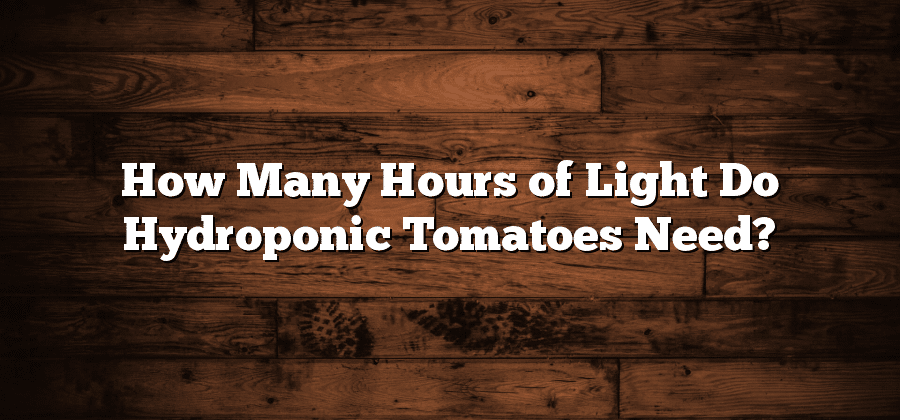Understanding the light requirements of hydroponic tomatoes
When it comes to growing hydroponic tomatoes, understanding their light requirements is essential for a successful yield. Light plays a vital role in the growth and development of tomato plants, and providing adequate light is crucial for their overall health and productivity.
Tomatoes are considered a high light crop, meaning they require a significant amount of light to thrive. Without sufficient light, the plants may become weak, leggy, and produce fewer fruits. It is important to note that tomato plants require both quantity and quality of light for optimal growth. While they need a minimum of 6-8 hours of direct sunlight, the quality of light is equally important. Therefore, it’s imperative to ensure that the light source closely mimics natural sunlight, providing the necessary intensity and spectrum for the plants to flourish.
The importance of providing adequate light for hydroponic tomatoes
Hydroponic tomatoes, being grown without the use of soil, rely heavily on the provision of adequate light for their growth and development. The importance of providing sufficient light cannot be overstated as it directly affects several key aspects of the plant’s health and productivity.
First and foremost, light is essential for the process of photosynthesis, where plants convert light energy into chemical energy, ultimately facilitating the production of sugars and carbohydrates necessary for growth. Without enough light, hydroponic tomatoes will struggle to create the energy needed to sustain their metabolic processes, resulting in stunted growth and reduced yield. Furthermore, light also plays a critical role in influencing various plant functions, such as root development, flowering, and even fruit quality. Insufficient light can lead to weak root systems, delayed or poor flowering, and subpar fruit formation. Therefore, providing the right amount and quality of light is paramount for hydroponic tomato growers to ensure healthy and high-yielding plants.
Factors that influence the light needs of hydroponic tomatoes
Factors that influence the light needs of hydroponic tomatoes:
Temperature: The temperature at which hydroponic tomatoes are grown plays a significant role in determining their light requirements. Tomatoes generally thrive in warmer temperatures, and the amount of light they need may vary according to the season. During colder months, when temperatures are lower, tomatoes may require more artificial light to supplement the lack of natural sunlight.
Stage of Growth: Another factor that influences the light needs of hydroponic tomatoes is their stage of growth. Seedlings and young plants require less light compared to mature plants that are in the fruiting or flowering stage. As tomatoes grow and develop, their light requirements increase to support photosynthesis and promote healthy growth. Properly adjusting the duration and intensity of light throughout each stage of growth can ensure optimal development and yield for hydroponic tomatoes.
Determining the ideal duration of light for hydroponic tomatoes
The duration of light plays a crucial role in the growth and development of hydroponic tomatoes. Determining the ideal duration of light can significantly impact the productivity and quality of the tomatoes.
To determine the optimal duration of light, several factors need to be considered. Firstly, it is important to understand the specific light requirements of the tomato variety being grown. Different varieties may have varying needs for light exposure. Secondly, the stage of growth should also be taken into account. Seedlings, vegetative plants, and flowering plants may require different durations of light to optimize their growth. Lastly, the overall environmental conditions, such as temperature and humidity, should be considered, as they can also influence the light requirements of hydroponic tomatoes.
Identifying the ideal duration of light for hydroponic tomatoes is essential for achieving maximum yields and ensuring healthy plant growth. Researchers and growers alike continue to study and experiment with different light durations to refine cultivation techniques and improve tomato production. As our understanding of the light requirements of hydroponic tomatoes evolves, it becomes increasingly important to tailor light schedules to meet the specific needs of each plant. By finding the perfect balance of light duration, growers can enhance the overall efficiency and effectiveness of their hydroponic tomato production systems.
Differentiating between natural and artificial light for hydroponic tomatoes
Chapter 4: Understanding the Light Requirements of Hydroponic Tomatoes
As hydroponic farming gains popularity, growers are increasingly focused on providing the best possible light conditions for their crops. One key aspect that needs to be understood is the difference between natural and artificial light for hydroponic tomatoes. Natural light refers to the sunlight that the plants receive directly from the sun, while artificial light is generated by artificial sources such as LED lights or high-intensity discharge (HID) lamps.
The choice between natural and artificial light for hydroponic tomatoes depends on several factors. Natural light is abundant, easily accessible, and provides a wide spectrum of wavelengths that are essential for plant growth. It also offers the advantage of being free, reducing operational costs for growers. On the other hand, artificial light allows growers to have greater control over the light spectrum and intensity. This can be particularly beneficial in areas with limited sunlight, or when specific wavelengths need to be targeted to optimize tomato growth and development. Determining the ideal duration and intensity of light, whether natural or artificial, is crucial in creating optimal growing conditions for hydroponic tomatoes.






